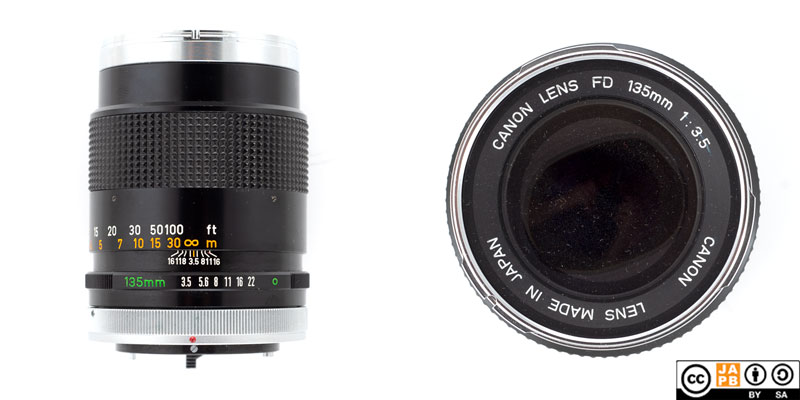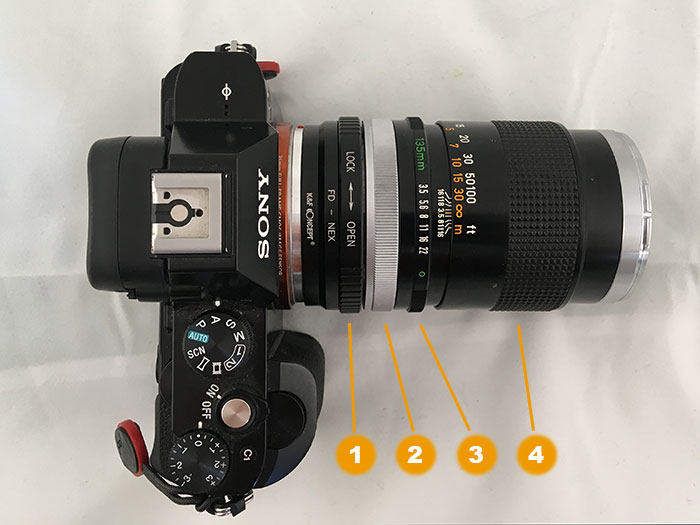Pekka Buttler, 08/2023

Specifications
The table below summarizes the lens’ key specifications:
| Brand: | Canon | Lens name | FD 135mm 1:3.5 |
| Focal length(s) 1 | 135 mm | Angle-of-view 2 | 18° |
| Maximum Aperture | f/3.5 | In Production | 1970–1973 |
| Lens mount | Canon FD | Subfamily (if applicable) | FD chrome nose |
| Length 3 | 86,4 mm | Diameter 4 | 64,7 mm |
| Filter ring diameter | 55 mm | Weight | 508 grams |
| Lens element count | 4 | Lens group count | 3 |
| Aperture blades (S/R/C) 5 | 8 S | Focus throw | 260 ° |
| Minimum focusing distance | 1,5 m | Maximum magnification | 1:9 |
| Has manual aperture ring | YES | Has Manual focus ring | YES |
| Aperture mechanism type | Automatic | Aperture click stops 6 | 3.5•5-6•8•11•16•22 |
Further notes:
• Among the earliest FD lenses to have been introduced, this (chrome nose) lens was replaced in 1973 with a lens of largely identical specifications (known as the FD 135mm f/3.5 S.C. (I).
• See more about the development of the slower Canon 135 mm lenses under ‘versions’
• Alike most Canon FD lenses, the lens front sports both a filter ring (55 mm) as well as grooves for mounting a bayonet-type lens hood.
• The BT-55B is the dedicated lens hood for this lens.
The history of Canon FD chrome nose lenses
Feel free to browse the JAPB article on the Canon FD mount for all the details. Below is an outline of the position of the Canon FD mount in Canon’s development trajectory:
• 1959–1963: R-mount. Canon’s first SLR lens mount. Breech lock-type mount with aperture semi-automation (camera is able to stop down lens for taking the shot, but lens needs to be opened up by user action) .
• 1964–1969: FL-mount. Breech-lock type mount, physically similar mount as Canon R-mount, but camera-to-lens communication linkages somewhat different. Cannot communicate selected aperture to body (stop-down-metering only).
• 1970–1978: FD-mount. Breech-lock mount. FD lenses compatible with FL-cameras and vice versa. Manual focus lenses that communicate aperture information to camera, hence opening the door for automatic exposure (both shutter priority and aperture priority possible)
• 1979–1986: new FD-mount (a.k.a. FDn). Bayonet mount, backwards compatible with FL and FD mounts. Otherwise, as FD mount.
• 1987–today: EF-mount. Electronically controlled autofocus lenses that use an internal focusing motor. Compatible with previous mount lenses only using an adapter with optics.
The era of the Canon FD mount can be characterised by a gradual shift towards the ever-increasing use of plastics and lighter materials. In the chronology of this gradual shift:
• Chrome nose FD lenses (1971–1973) are solid metal (often brass), glass and (synthetic) rubber.
• Black nose FD lenses (1973-≈1975) are also metal, glass and rubber, but often 5-10% less heavy than chrome nose lenses.
• Late FD, (≈1975–1979) rubber is replaced by plastic and heavier metals are gradually replaced by lighter alloys
(FDn lenses (1979–1987) typically make extensive use of light alloys as well as, increasingly, plastics while in the EF era (1987 onwards) plastics fully take over)
Interestingly, when Canon introduced the FD mount and its lineup of lenses, not all lenses introduced early on sported a chrome nose. Also there are some cases where Canon marketing material showed a specific lens with a chrome nose, only to never have been seen since. I have personally seen the following lenses as chrome nose models: 24/2.8; 28/3.5; 35/2; 35/3.5; 50/1.4; 50/1.8; 55/1.2; 55/1.2 AL; 100/2.8, and 135/3.5.
Versions
Canon has a long history of manufacturing f/3.5 135 mm lenses, that can be summarised (based on data from the Canon camera museum) as:
• R 135 mm f/3.5 (I) (1959–1961), 4 elements in 3 groups, 48 mm filter, 10 blades, 370 grams
• R 135 mm f/3.5 (II) (1961–1966), 4 elements in 3 groups, 48 mm filter, 10 blades, 350 grams
• FL 135 mm f/3.5 (1966–1970), 4 elements in 3 groups, 48 mm filter, 8 blades, 434 grams [data sheet]
• FD 135 mm f/3.5 chrome nose (1970–1973), 4 elements in 3 groups, 55 mm filter, 8 blades, 480 grams [this lens]
• FD 135 mm f/3.5 S.C. (I) (1973–1976), 4 elements in 3 groups, 55 mm filter, 8 blades, 465 grams [data sheet]
• FD 135 mm f/3.5 S.C. (II) (1976–1979), 4 elements in 4 groups, 55 mm filter, 6 blades, 385 grams
• FDn 135 mm f/3.5 (1979–1987), 4 elements in 4 groups, 52 mm filter, 6 blades, 325 grams [data sheet]
Adapting
n.B! As chrome nose lenses are 100% Canon FD lenses, the following applies to all Canon FD lenses:
This lens cannot be used natively on any current SLR or dSLRs. To use it in its native environment, you will need a Canon FD-mount film body. I’ve personally shot my chrome nose 50/1.4 on a Canon F-1 to great effect.
Thanks to being a fully manual lens (manual aperture, manual focus), the lens can be adapted to all mirrorless cameras using a suitable adapter. However, for the adapter to allow the lens to stop down, you will need an adapter that can be set to engage the FD lens’ aperture control lever. Personally, this is my biggest gripe with the FD-mounts as this leads to what I refer to as the four-ring problem:

[1] Activation ring for aperture control
[2] Locking ring for breech-lock mount
[3] Aperture ring
[4] Focus ring
Note, that especially the first three rings are very close together.
Moreover, a large range of special adapters (helicoid adapters, tilt/shift adapters, speed boosters) for using Canon FD lenses on most mirrorless systems are available.
Using Canon FD lenses on dSLRs is a possibility, but is not problem free. Thanks to the relatively short flange focal distance of the Canon FD mount (at 42,0 mm, clearly shorter than that of any full-frame dSLR mount), any adapter will necessitate some optics to achieve infinity focus.
Footnotes
- Focal length is (unless stated otherwise) given in absolute terms, and not in Full-frame equivalent. For an understanding of whether the lens is wide/tele, see ‘Angle-of-view’. ↩︎
- Picture angle is given in degrees and concerns the diagonal picture angle. Rule of thumb:
> 90 ° ==> Ultra-wide-angle
70–90 ° ==> Wide-angle
50–70 ° ==> Moderate wide-angle
40–50 ° ==> ‘Standard’ or ‘normal’ lens
20–40 ° ==> Short tele lens
10-20 ° ==> Tele lens
5-10 ° ==> Long tele lens
< 5 ° ==> Ultra-tele lens ↩︎ - Length is given from the mount flange to the front of lens at infinity. ↩︎
- Diameter excludes protrusions such as rabbit ears or stop-down levers. ↩︎
- S=straight; R=rounded; C=(almost)circular at all apertures. ↩︎
- Numbers equal aperture values on aperture ring; • intermediate click; – no intermediate click. ↩︎